Exploring the Power of Media in Contemporary Australian Politics
VerifiedAdded on 2023/04/21
|9
|2633
|181
Essay
AI Summary
This essay examines the power and influence of media in contemporary Australian politics, highlighting its role in shaping political agendas and public opinion. It discusses how politicians, journalists, and citizens leverage media tools to achieve their political goals, noting a shift in media from objective reporting to becoming a political instrument. The research emphasizes the impact of social media, 24-hour news channels, and online campaigns on the Australian political landscape, using examples such as Kelvin Rudd's effective use of social media and the advocacy group "Get Up!"'s success in electoral reform. It concludes that media has a significant role in determining the political climate, but it should ideally serve as an independent mirror of society rather than a tool for political gain, advocating for a restoration of its original role to ensure a fair political system.
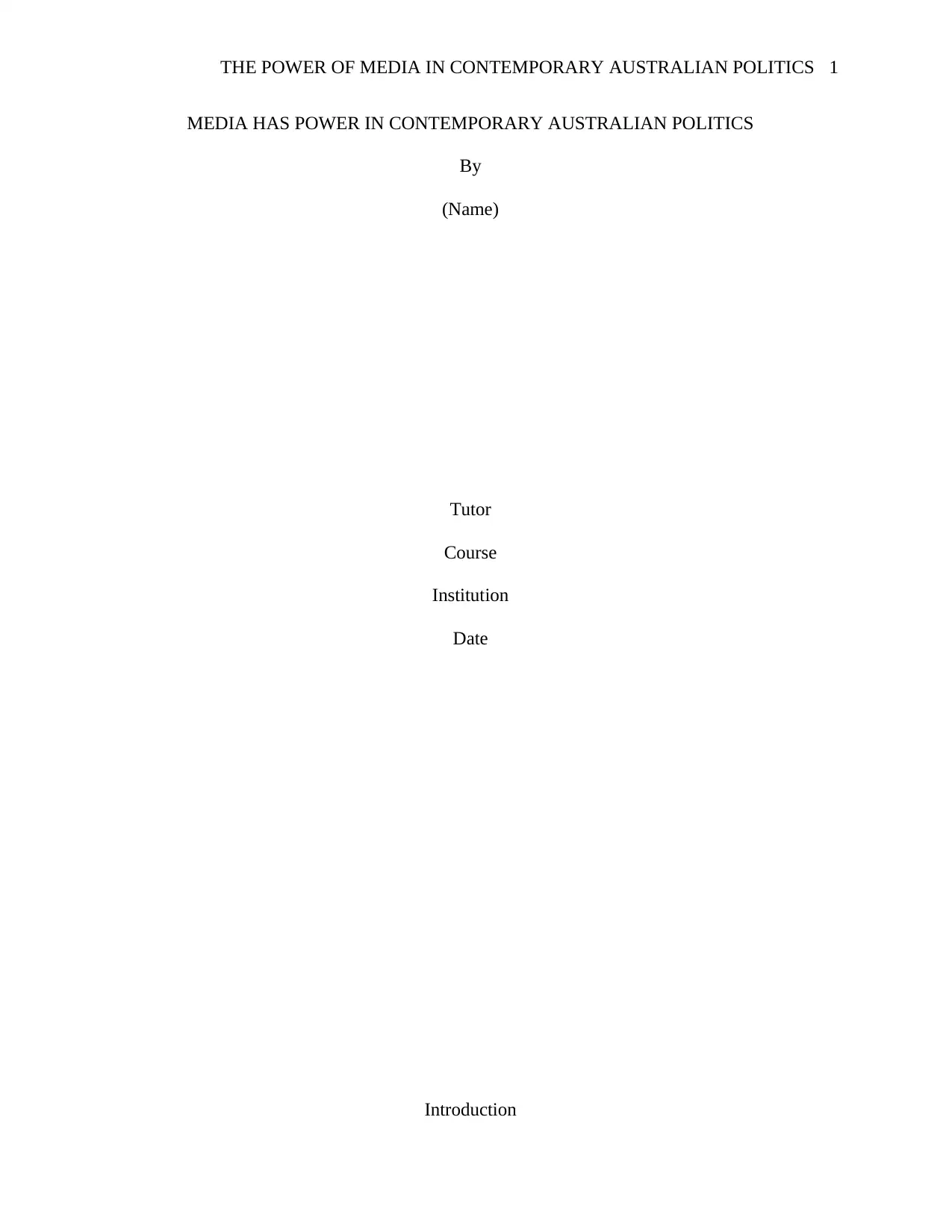
THE POWER OF MEDIA IN CONTEMPORARY AUSTRALIAN POLITICS 1
MEDIA HAS POWER IN CONTEMPORARY AUSTRALIAN POLITICS
By
(Name)
Tutor
Course
Institution
Date
Introduction
MEDIA HAS POWER IN CONTEMPORARY AUSTRALIAN POLITICS
By
(Name)
Tutor
Course
Institution
Date
Introduction
Paraphrase This Document
Need a fresh take? Get an instant paraphrase of this document with our AI Paraphraser
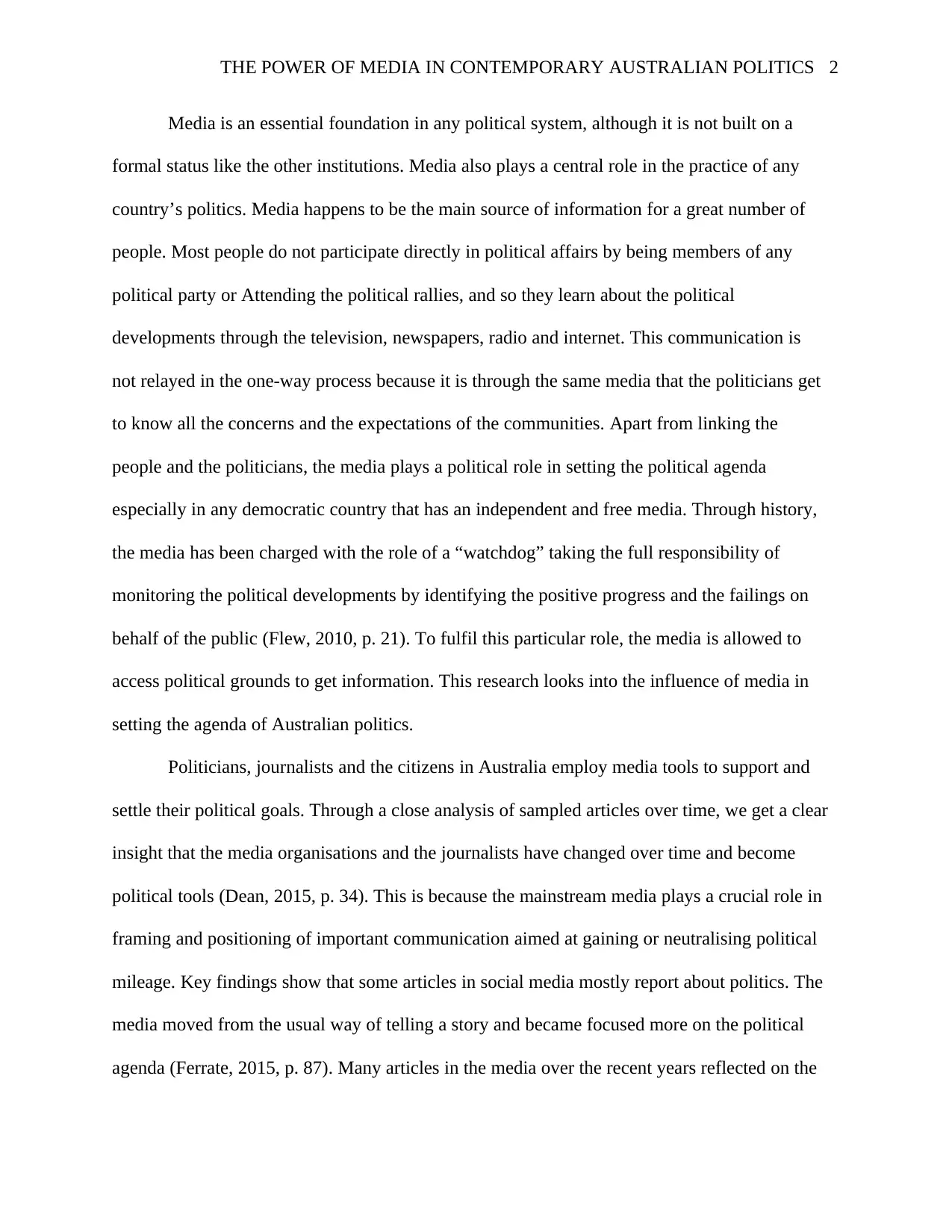
THE POWER OF MEDIA IN CONTEMPORARY AUSTRALIAN POLITICS 2
Media is an essential foundation in any political system, although it is not built on a
formal status like the other institutions. Media also plays a central role in the practice of any
country’s politics. Media happens to be the main source of information for a great number of
people. Most people do not participate directly in political affairs by being members of any
political party or Attending the political rallies, and so they learn about the political
developments through the television, newspapers, radio and internet. This communication is
not relayed in the one-way process because it is through the same media that the politicians get
to know all the concerns and the expectations of the communities. Apart from linking the
people and the politicians, the media plays a political role in setting the political agenda
especially in any democratic country that has an independent and free media. Through history,
the media has been charged with the role of a “watchdog” taking the full responsibility of
monitoring the political developments by identifying the positive progress and the failings on
behalf of the public (Flew, 2010, p. 21). To fulfil this particular role, the media is allowed to
access political grounds to get information. This research looks into the influence of media in
setting the agenda of Australian politics.
Politicians, journalists and the citizens in Australia employ media tools to support and
settle their political goals. Through a close analysis of sampled articles over time, we get a clear
insight that the media organisations and the journalists have changed over time and become
political tools (Dean, 2015, p. 34). This is because the mainstream media plays a crucial role in
framing and positioning of important communication aimed at gaining or neutralising political
mileage. Key findings show that some articles in social media mostly report about politics. The
media moved from the usual way of telling a story and became focused more on the political
agenda (Ferrate, 2015, p. 87). Many articles in the media over the recent years reflected on the
Media is an essential foundation in any political system, although it is not built on a
formal status like the other institutions. Media also plays a central role in the practice of any
country’s politics. Media happens to be the main source of information for a great number of
people. Most people do not participate directly in political affairs by being members of any
political party or Attending the political rallies, and so they learn about the political
developments through the television, newspapers, radio and internet. This communication is
not relayed in the one-way process because it is through the same media that the politicians get
to know all the concerns and the expectations of the communities. Apart from linking the
people and the politicians, the media plays a political role in setting the political agenda
especially in any democratic country that has an independent and free media. Through history,
the media has been charged with the role of a “watchdog” taking the full responsibility of
monitoring the political developments by identifying the positive progress and the failings on
behalf of the public (Flew, 2010, p. 21). To fulfil this particular role, the media is allowed to
access political grounds to get information. This research looks into the influence of media in
setting the agenda of Australian politics.
Politicians, journalists and the citizens in Australia employ media tools to support and
settle their political goals. Through a close analysis of sampled articles over time, we get a clear
insight that the media organisations and the journalists have changed over time and become
political tools (Dean, 2015, p. 34). This is because the mainstream media plays a crucial role in
framing and positioning of important communication aimed at gaining or neutralising political
mileage. Key findings show that some articles in social media mostly report about politics. The
media moved from the usual way of telling a story and became focused more on the political
agenda (Ferrate, 2015, p. 87). Many articles in the media over the recent years reflected on the
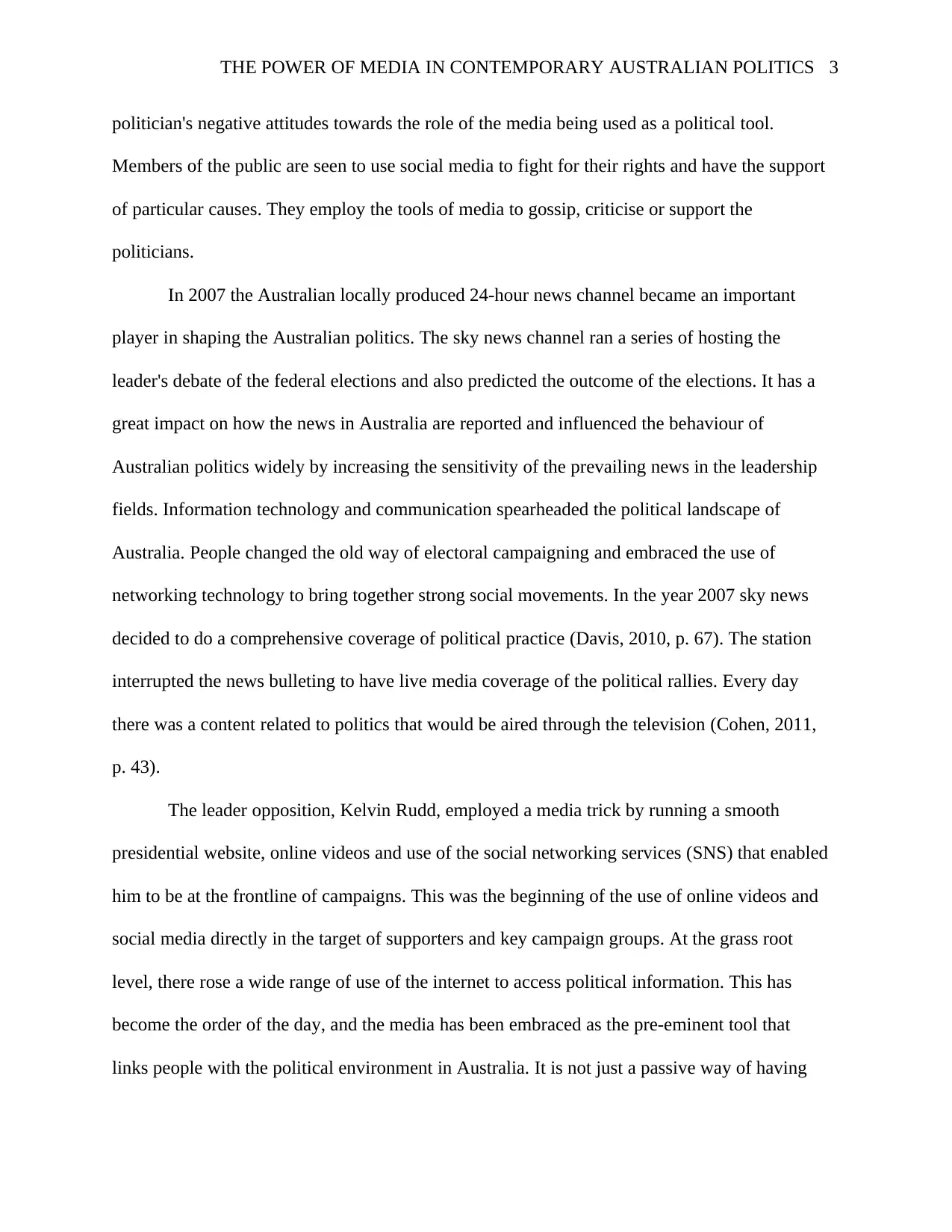
THE POWER OF MEDIA IN CONTEMPORARY AUSTRALIAN POLITICS 3
politician's negative attitudes towards the role of the media being used as a political tool.
Members of the public are seen to use social media to fight for their rights and have the support
of particular causes. They employ the tools of media to gossip, criticise or support the
politicians.
In 2007 the Australian locally produced 24-hour news channel became an important
player in shaping the Australian politics. The sky news channel ran a series of hosting the
leader's debate of the federal elections and also predicted the outcome of the elections. It has a
great impact on how the news in Australia are reported and influenced the behaviour of
Australian politics widely by increasing the sensitivity of the prevailing news in the leadership
fields. Information technology and communication spearheaded the political landscape of
Australia. People changed the old way of electoral campaigning and embraced the use of
networking technology to bring together strong social movements. In the year 2007 sky news
decided to do a comprehensive coverage of political practice (Davis, 2010, p. 67). The station
interrupted the news bulleting to have live media coverage of the political rallies. Every day
there was a content related to politics that would be aired through the television (Cohen, 2011,
p. 43).
The leader opposition, Kelvin Rudd, employed a media trick by running a smooth
presidential website, online videos and use of the social networking services (SNS) that enabled
him to be at the frontline of campaigns. This was the beginning of the use of online videos and
social media directly in the target of supporters and key campaign groups. At the grass root
level, there rose a wide range of use of the internet to access political information. This has
become the order of the day, and the media has been embraced as the pre-eminent tool that
links people with the political environment in Australia. It is not just a passive way of having
politician's negative attitudes towards the role of the media being used as a political tool.
Members of the public are seen to use social media to fight for their rights and have the support
of particular causes. They employ the tools of media to gossip, criticise or support the
politicians.
In 2007 the Australian locally produced 24-hour news channel became an important
player in shaping the Australian politics. The sky news channel ran a series of hosting the
leader's debate of the federal elections and also predicted the outcome of the elections. It has a
great impact on how the news in Australia are reported and influenced the behaviour of
Australian politics widely by increasing the sensitivity of the prevailing news in the leadership
fields. Information technology and communication spearheaded the political landscape of
Australia. People changed the old way of electoral campaigning and embraced the use of
networking technology to bring together strong social movements. In the year 2007 sky news
decided to do a comprehensive coverage of political practice (Davis, 2010, p. 67). The station
interrupted the news bulleting to have live media coverage of the political rallies. Every day
there was a content related to politics that would be aired through the television (Cohen, 2011,
p. 43).
The leader opposition, Kelvin Rudd, employed a media trick by running a smooth
presidential website, online videos and use of the social networking services (SNS) that enabled
him to be at the frontline of campaigns. This was the beginning of the use of online videos and
social media directly in the target of supporters and key campaign groups. At the grass root
level, there rose a wide range of use of the internet to access political information. This has
become the order of the day, and the media has been embraced as the pre-eminent tool that
links people with the political environment in Australia. It is not just a passive way of having
⊘ This is a preview!⊘
Do you want full access?
Subscribe today to unlock all pages.

Trusted by 1+ million students worldwide
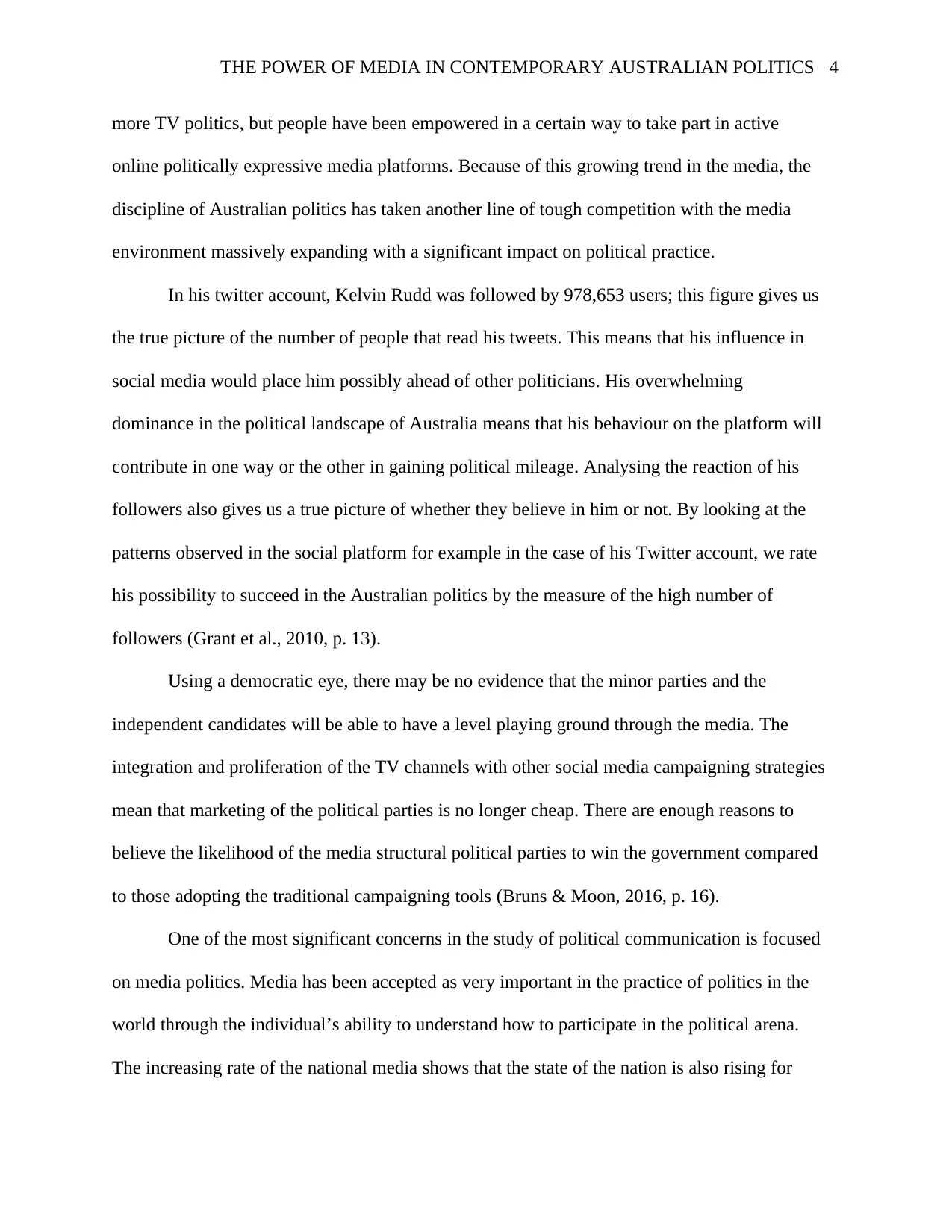
THE POWER OF MEDIA IN CONTEMPORARY AUSTRALIAN POLITICS 4
more TV politics, but people have been empowered in a certain way to take part in active
online politically expressive media platforms. Because of this growing trend in the media, the
discipline of Australian politics has taken another line of tough competition with the media
environment massively expanding with a significant impact on political practice.
In his twitter account, Kelvin Rudd was followed by 978,653 users; this figure gives us
the true picture of the number of people that read his tweets. This means that his influence in
social media would place him possibly ahead of other politicians. His overwhelming
dominance in the political landscape of Australia means that his behaviour on the platform will
contribute in one way or the other in gaining political mileage. Analysing the reaction of his
followers also gives us a true picture of whether they believe in him or not. By looking at the
patterns observed in the social platform for example in the case of his Twitter account, we rate
his possibility to succeed in the Australian politics by the measure of the high number of
followers (Grant et al., 2010, p. 13).
Using a democratic eye, there may be no evidence that the minor parties and the
independent candidates will be able to have a level playing ground through the media. The
integration and proliferation of the TV channels with other social media campaigning strategies
mean that marketing of the political parties is no longer cheap. There are enough reasons to
believe the likelihood of the media structural political parties to win the government compared
to those adopting the traditional campaigning tools (Bruns & Moon, 2016, p. 16).
One of the most significant concerns in the study of political communication is focused
on media politics. Media has been accepted as very important in the practice of politics in the
world through the individual’s ability to understand how to participate in the political arena.
The increasing rate of the national media shows that the state of the nation is also rising for
more TV politics, but people have been empowered in a certain way to take part in active
online politically expressive media platforms. Because of this growing trend in the media, the
discipline of Australian politics has taken another line of tough competition with the media
environment massively expanding with a significant impact on political practice.
In his twitter account, Kelvin Rudd was followed by 978,653 users; this figure gives us
the true picture of the number of people that read his tweets. This means that his influence in
social media would place him possibly ahead of other politicians. His overwhelming
dominance in the political landscape of Australia means that his behaviour on the platform will
contribute in one way or the other in gaining political mileage. Analysing the reaction of his
followers also gives us a true picture of whether they believe in him or not. By looking at the
patterns observed in the social platform for example in the case of his Twitter account, we rate
his possibility to succeed in the Australian politics by the measure of the high number of
followers (Grant et al., 2010, p. 13).
Using a democratic eye, there may be no evidence that the minor parties and the
independent candidates will be able to have a level playing ground through the media. The
integration and proliferation of the TV channels with other social media campaigning strategies
mean that marketing of the political parties is no longer cheap. There are enough reasons to
believe the likelihood of the media structural political parties to win the government compared
to those adopting the traditional campaigning tools (Bruns & Moon, 2016, p. 16).
One of the most significant concerns in the study of political communication is focused
on media politics. Media has been accepted as very important in the practice of politics in the
world through the individual’s ability to understand how to participate in the political arena.
The increasing rate of the national media shows that the state of the nation is also rising for
Paraphrase This Document
Need a fresh take? Get an instant paraphrase of this document with our AI Paraphraser
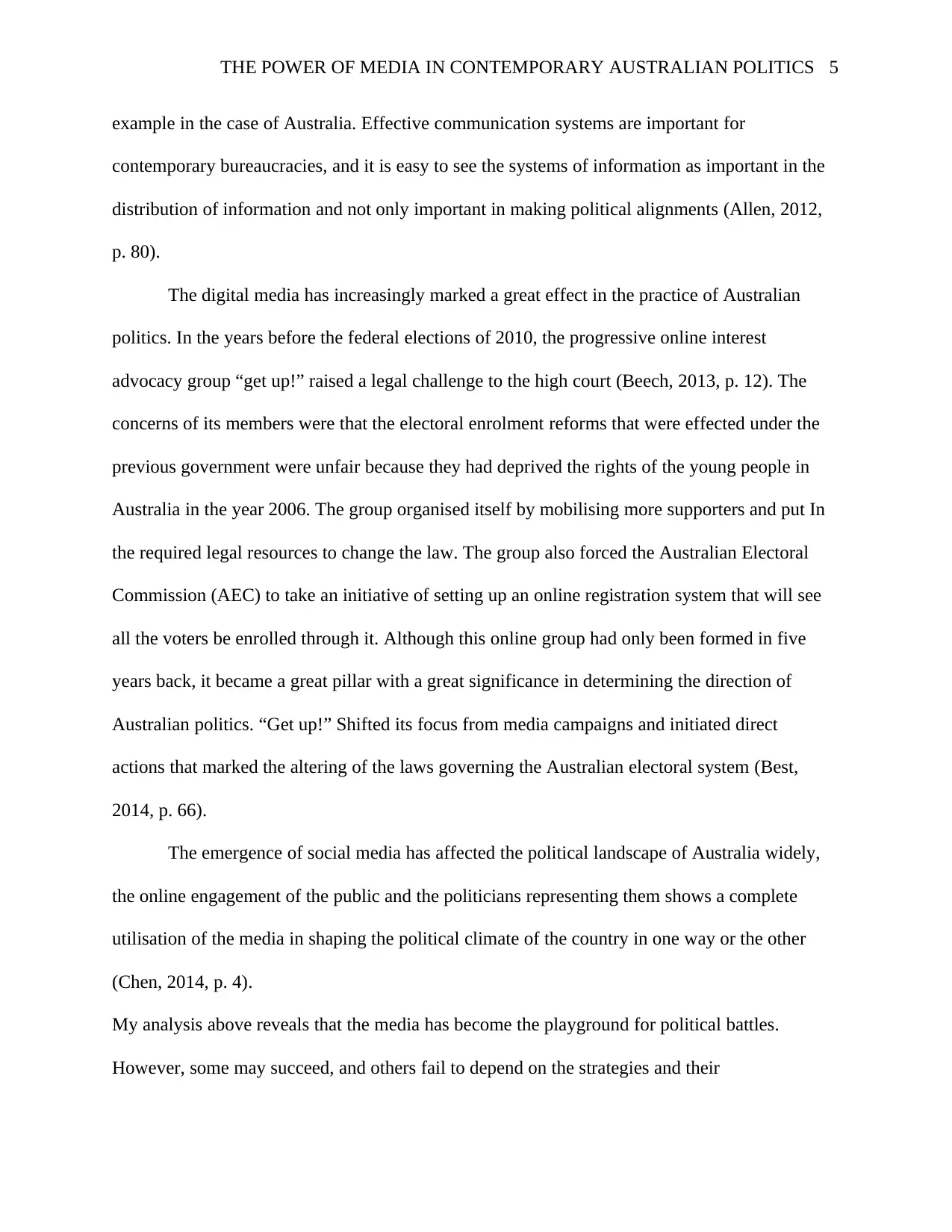
THE POWER OF MEDIA IN CONTEMPORARY AUSTRALIAN POLITICS 5
example in the case of Australia. Effective communication systems are important for
contemporary bureaucracies, and it is easy to see the systems of information as important in the
distribution of information and not only important in making political alignments (Allen, 2012,
p. 80).
The digital media has increasingly marked a great effect in the practice of Australian
politics. In the years before the federal elections of 2010, the progressive online interest
advocacy group “get up!” raised a legal challenge to the high court (Beech, 2013, p. 12). The
concerns of its members were that the electoral enrolment reforms that were effected under the
previous government were unfair because they had deprived the rights of the young people in
Australia in the year 2006. The group organised itself by mobilising more supporters and put In
the required legal resources to change the law. The group also forced the Australian Electoral
Commission (AEC) to take an initiative of setting up an online registration system that will see
all the voters be enrolled through it. Although this online group had only been formed in five
years back, it became a great pillar with a great significance in determining the direction of
Australian politics. “Get up!” Shifted its focus from media campaigns and initiated direct
actions that marked the altering of the laws governing the Australian electoral system (Best,
2014, p. 66).
The emergence of social media has affected the political landscape of Australia widely,
the online engagement of the public and the politicians representing them shows a complete
utilisation of the media in shaping the political climate of the country in one way or the other
(Chen, 2014, p. 4).
My analysis above reveals that the media has become the playground for political battles.
However, some may succeed, and others fail to depend on the strategies and their
example in the case of Australia. Effective communication systems are important for
contemporary bureaucracies, and it is easy to see the systems of information as important in the
distribution of information and not only important in making political alignments (Allen, 2012,
p. 80).
The digital media has increasingly marked a great effect in the practice of Australian
politics. In the years before the federal elections of 2010, the progressive online interest
advocacy group “get up!” raised a legal challenge to the high court (Beech, 2013, p. 12). The
concerns of its members were that the electoral enrolment reforms that were effected under the
previous government were unfair because they had deprived the rights of the young people in
Australia in the year 2006. The group organised itself by mobilising more supporters and put In
the required legal resources to change the law. The group also forced the Australian Electoral
Commission (AEC) to take an initiative of setting up an online registration system that will see
all the voters be enrolled through it. Although this online group had only been formed in five
years back, it became a great pillar with a great significance in determining the direction of
Australian politics. “Get up!” Shifted its focus from media campaigns and initiated direct
actions that marked the altering of the laws governing the Australian electoral system (Best,
2014, p. 66).
The emergence of social media has affected the political landscape of Australia widely,
the online engagement of the public and the politicians representing them shows a complete
utilisation of the media in shaping the political climate of the country in one way or the other
(Chen, 2014, p. 4).
My analysis above reveals that the media has become the playground for political battles.
However, some may succeed, and others fail to depend on the strategies and their
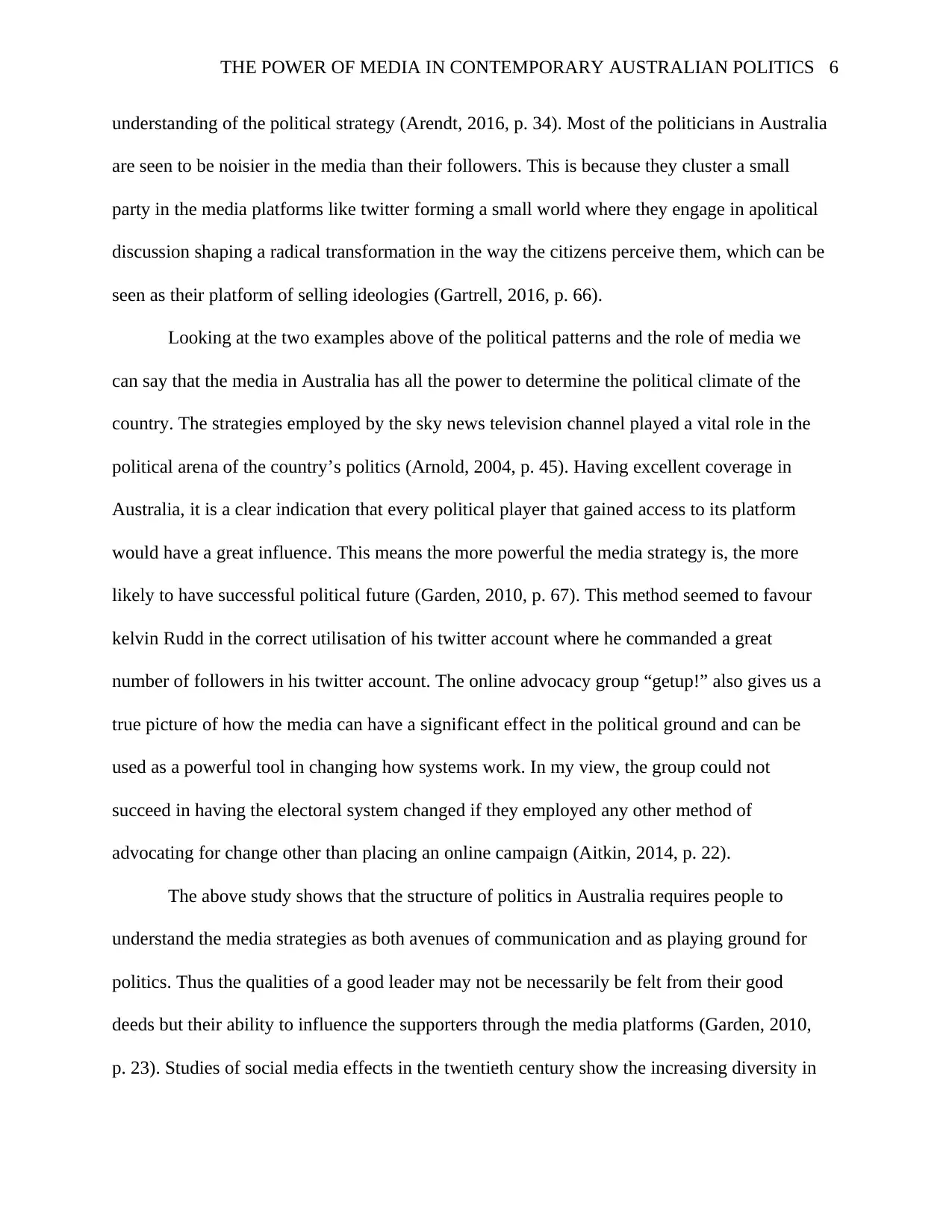
THE POWER OF MEDIA IN CONTEMPORARY AUSTRALIAN POLITICS 6
understanding of the political strategy (Arendt, 2016, p. 34). Most of the politicians in Australia
are seen to be noisier in the media than their followers. This is because they cluster a small
party in the media platforms like twitter forming a small world where they engage in apolitical
discussion shaping a radical transformation in the way the citizens perceive them, which can be
seen as their platform of selling ideologies (Gartrell, 2016, p. 66).
Looking at the two examples above of the political patterns and the role of media we
can say that the media in Australia has all the power to determine the political climate of the
country. The strategies employed by the sky news television channel played a vital role in the
political arena of the country’s politics (Arnold, 2004, p. 45). Having excellent coverage in
Australia, it is a clear indication that every political player that gained access to its platform
would have a great influence. This means the more powerful the media strategy is, the more
likely to have successful political future (Garden, 2010, p. 67). This method seemed to favour
kelvin Rudd in the correct utilisation of his twitter account where he commanded a great
number of followers in his twitter account. The online advocacy group “getup!” also gives us a
true picture of how the media can have a significant effect in the political ground and can be
used as a powerful tool in changing how systems work. In my view, the group could not
succeed in having the electoral system changed if they employed any other method of
advocating for change other than placing an online campaign (Aitkin, 2014, p. 22).
The above study shows that the structure of politics in Australia requires people to
understand the media strategies as both avenues of communication and as playing ground for
politics. Thus the qualities of a good leader may not be necessarily be felt from their good
deeds but their ability to influence the supporters through the media platforms (Garden, 2010,
p. 23). Studies of social media effects in the twentieth century show the increasing diversity in
understanding of the political strategy (Arendt, 2016, p. 34). Most of the politicians in Australia
are seen to be noisier in the media than their followers. This is because they cluster a small
party in the media platforms like twitter forming a small world where they engage in apolitical
discussion shaping a radical transformation in the way the citizens perceive them, which can be
seen as their platform of selling ideologies (Gartrell, 2016, p. 66).
Looking at the two examples above of the political patterns and the role of media we
can say that the media in Australia has all the power to determine the political climate of the
country. The strategies employed by the sky news television channel played a vital role in the
political arena of the country’s politics (Arnold, 2004, p. 45). Having excellent coverage in
Australia, it is a clear indication that every political player that gained access to its platform
would have a great influence. This means the more powerful the media strategy is, the more
likely to have successful political future (Garden, 2010, p. 67). This method seemed to favour
kelvin Rudd in the correct utilisation of his twitter account where he commanded a great
number of followers in his twitter account. The online advocacy group “getup!” also gives us a
true picture of how the media can have a significant effect in the political ground and can be
used as a powerful tool in changing how systems work. In my view, the group could not
succeed in having the electoral system changed if they employed any other method of
advocating for change other than placing an online campaign (Aitkin, 2014, p. 22).
The above study shows that the structure of politics in Australia requires people to
understand the media strategies as both avenues of communication and as playing ground for
politics. Thus the qualities of a good leader may not be necessarily be felt from their good
deeds but their ability to influence the supporters through the media platforms (Garden, 2010,
p. 23). Studies of social media effects in the twentieth century show the increasing diversity in
⊘ This is a preview!⊘
Do you want full access?
Subscribe today to unlock all pages.

Trusted by 1+ million students worldwide
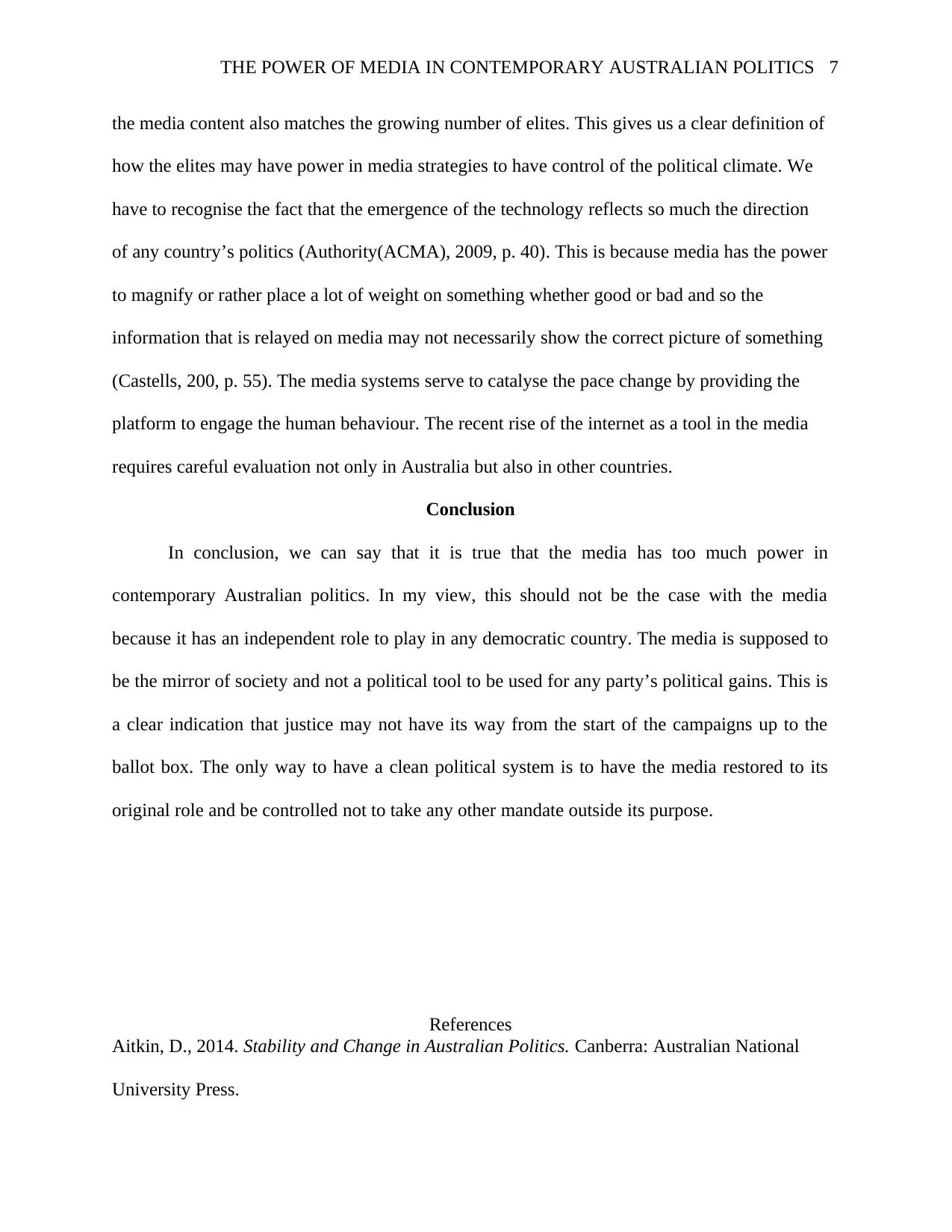
THE POWER OF MEDIA IN CONTEMPORARY AUSTRALIAN POLITICS 7
the media content also matches the growing number of elites. This gives us a clear definition of
how the elites may have power in media strategies to have control of the political climate. We
have to recognise the fact that the emergence of the technology reflects so much the direction
of any country’s politics (Authority(ACMA), 2009, p. 40). This is because media has the power
to magnify or rather place a lot of weight on something whether good or bad and so the
information that is relayed on media may not necessarily show the correct picture of something
(Castells, 200, p. 55). The media systems serve to catalyse the pace change by providing the
platform to engage the human behaviour. The recent rise of the internet as a tool in the media
requires careful evaluation not only in Australia but also in other countries.
Conclusion
In conclusion, we can say that it is true that the media has too much power in
contemporary Australian politics. In my view, this should not be the case with the media
because it has an independent role to play in any democratic country. The media is supposed to
be the mirror of society and not a political tool to be used for any party’s political gains. This is
a clear indication that justice may not have its way from the start of the campaigns up to the
ballot box. The only way to have a clean political system is to have the media restored to its
original role and be controlled not to take any other mandate outside its purpose.
References
Aitkin, D., 2014. Stability and Change in Australian Politics. Canberra: Australian National
University Press.
the media content also matches the growing number of elites. This gives us a clear definition of
how the elites may have power in media strategies to have control of the political climate. We
have to recognise the fact that the emergence of the technology reflects so much the direction
of any country’s politics (Authority(ACMA), 2009, p. 40). This is because media has the power
to magnify or rather place a lot of weight on something whether good or bad and so the
information that is relayed on media may not necessarily show the correct picture of something
(Castells, 200, p. 55). The media systems serve to catalyse the pace change by providing the
platform to engage the human behaviour. The recent rise of the internet as a tool in the media
requires careful evaluation not only in Australia but also in other countries.
Conclusion
In conclusion, we can say that it is true that the media has too much power in
contemporary Australian politics. In my view, this should not be the case with the media
because it has an independent role to play in any democratic country. The media is supposed to
be the mirror of society and not a political tool to be used for any party’s political gains. This is
a clear indication that justice may not have its way from the start of the campaigns up to the
ballot box. The only way to have a clean political system is to have the media restored to its
original role and be controlled not to take any other mandate outside its purpose.
References
Aitkin, D., 2014. Stability and Change in Australian Politics. Canberra: Australian National
University Press.
Paraphrase This Document
Need a fresh take? Get an instant paraphrase of this document with our AI Paraphraser
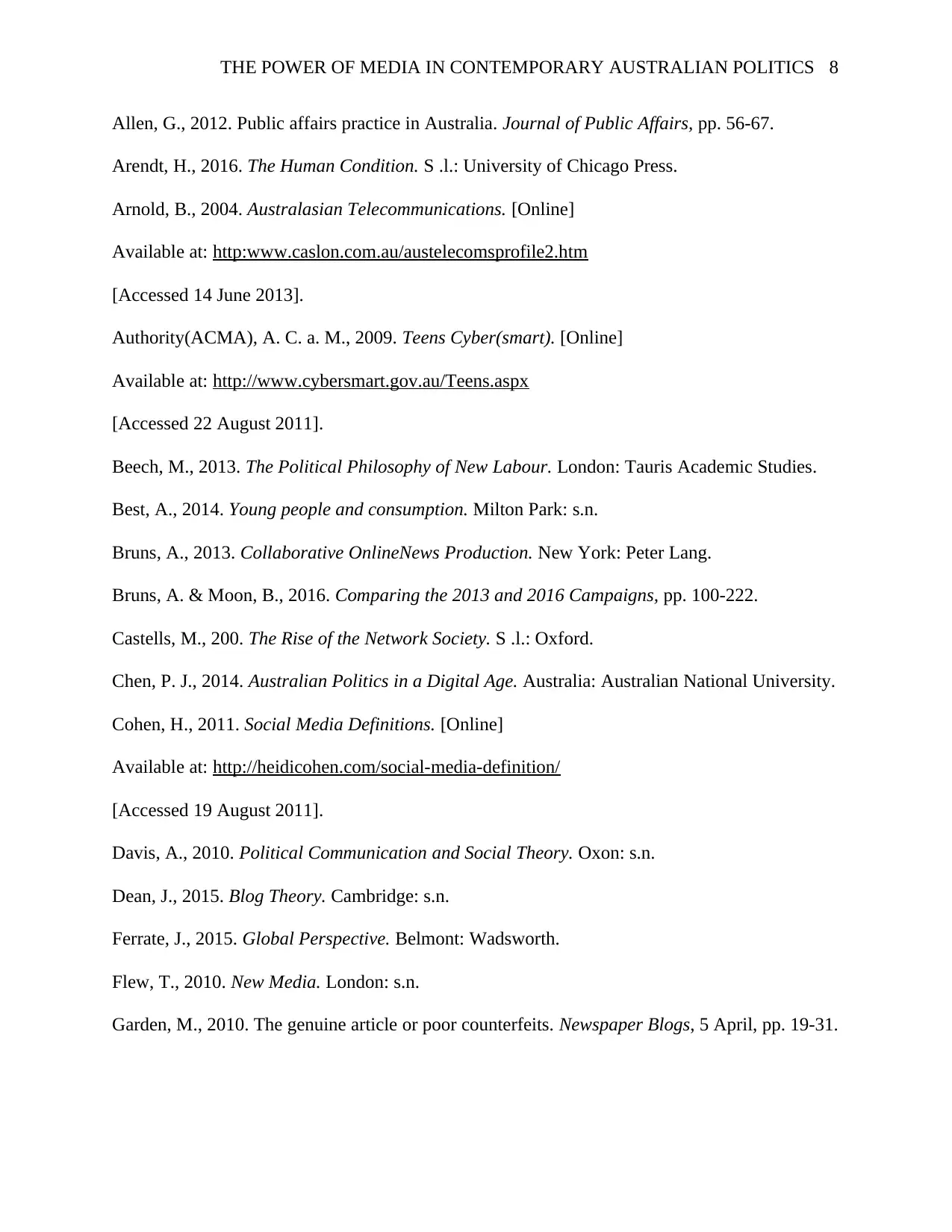
THE POWER OF MEDIA IN CONTEMPORARY AUSTRALIAN POLITICS 8
Allen, G., 2012. Public affairs practice in Australia. Journal of Public Affairs, pp. 56-67.
Arendt, H., 2016. The Human Condition. S .l.: University of Chicago Press.
Arnold, B., 2004. Australasian Telecommunications. [Online]
Available at: http:www.caslon.com.au/austelecomsprofile2.htm
[Accessed 14 June 2013].
Authority(ACMA), A. C. a. M., 2009. Teens Cyber(smart). [Online]
Available at: http://www.cybersmart.gov.au/Teens.aspx
[Accessed 22 August 2011].
Beech, M., 2013. The Political Philosophy of New Labour. London: Tauris Academic Studies.
Best, A., 2014. Young people and consumption. Milton Park: s.n.
Bruns, A., 2013. Collaborative OnlineNews Production. New York: Peter Lang.
Bruns, A. & Moon, B., 2016. Comparing the 2013 and 2016 Campaigns, pp. 100-222.
Castells, M., 200. The Rise of the Network Society. S .l.: Oxford.
Chen, P. J., 2014. Australian Politics in a Digital Age. Australia: Australian National University.
Cohen, H., 2011. Social Media Definitions. [Online]
Available at: http://heidicohen.com/social-media-definition/
[Accessed 19 August 2011].
Davis, A., 2010. Political Communication and Social Theory. Oxon: s.n.
Dean, J., 2015. Blog Theory. Cambridge: s.n.
Ferrate, J., 2015. Global Perspective. Belmont: Wadsworth.
Flew, T., 2010. New Media. London: s.n.
Garden, M., 2010. The genuine article or poor counterfeits. Newspaper Blogs, 5 April, pp. 19-31.
Allen, G., 2012. Public affairs practice in Australia. Journal of Public Affairs, pp. 56-67.
Arendt, H., 2016. The Human Condition. S .l.: University of Chicago Press.
Arnold, B., 2004. Australasian Telecommunications. [Online]
Available at: http:www.caslon.com.au/austelecomsprofile2.htm
[Accessed 14 June 2013].
Authority(ACMA), A. C. a. M., 2009. Teens Cyber(smart). [Online]
Available at: http://www.cybersmart.gov.au/Teens.aspx
[Accessed 22 August 2011].
Beech, M., 2013. The Political Philosophy of New Labour. London: Tauris Academic Studies.
Best, A., 2014. Young people and consumption. Milton Park: s.n.
Bruns, A., 2013. Collaborative OnlineNews Production. New York: Peter Lang.
Bruns, A. & Moon, B., 2016. Comparing the 2013 and 2016 Campaigns, pp. 100-222.
Castells, M., 200. The Rise of the Network Society. S .l.: Oxford.
Chen, P. J., 2014. Australian Politics in a Digital Age. Australia: Australian National University.
Cohen, H., 2011. Social Media Definitions. [Online]
Available at: http://heidicohen.com/social-media-definition/
[Accessed 19 August 2011].
Davis, A., 2010. Political Communication and Social Theory. Oxon: s.n.
Dean, J., 2015. Blog Theory. Cambridge: s.n.
Ferrate, J., 2015. Global Perspective. Belmont: Wadsworth.
Flew, T., 2010. New Media. London: s.n.
Garden, M., 2010. The genuine article or poor counterfeits. Newspaper Blogs, 5 April, pp. 19-31.
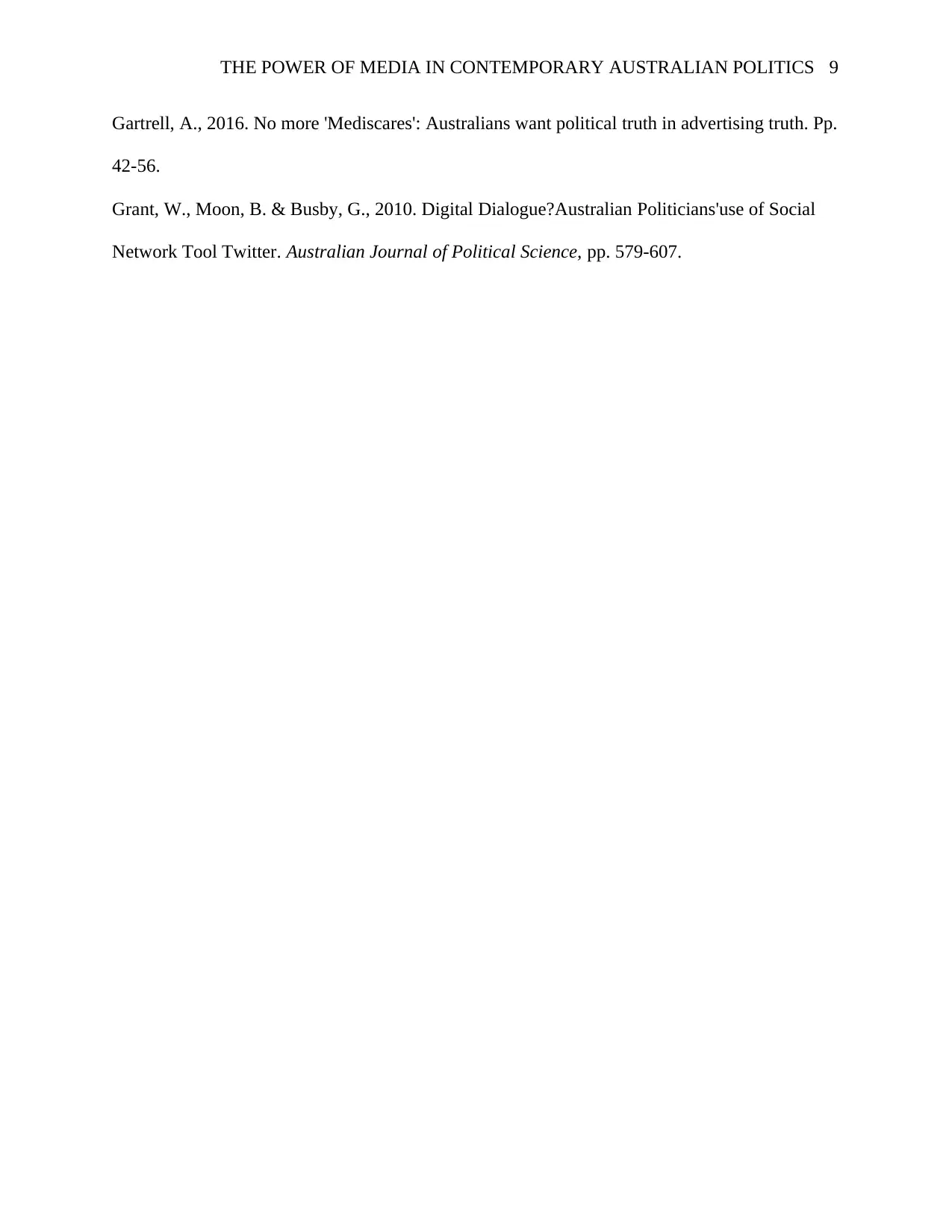
THE POWER OF MEDIA IN CONTEMPORARY AUSTRALIAN POLITICS 9
Gartrell, A., 2016. No more 'Mediscares': Australians want political truth in advertising truth. Pp.
42-56.
Grant, W., Moon, B. & Busby, G., 2010. Digital Dialogue?Australian Politicians'use of Social
Network Tool Twitter. Australian Journal of Political Science, pp. 579-607.
Gartrell, A., 2016. No more 'Mediscares': Australians want political truth in advertising truth. Pp.
42-56.
Grant, W., Moon, B. & Busby, G., 2010. Digital Dialogue?Australian Politicians'use of Social
Network Tool Twitter. Australian Journal of Political Science, pp. 579-607.
⊘ This is a preview!⊘
Do you want full access?
Subscribe today to unlock all pages.

Trusted by 1+ million students worldwide
1 out of 9
Related Documents
Your All-in-One AI-Powered Toolkit for Academic Success.
+13062052269
info@desklib.com
Available 24*7 on WhatsApp / Email
![[object Object]](/_next/static/media/star-bottom.7253800d.svg)
Unlock your academic potential
Copyright © 2020–2025 A2Z Services. All Rights Reserved. Developed and managed by ZUCOL.



